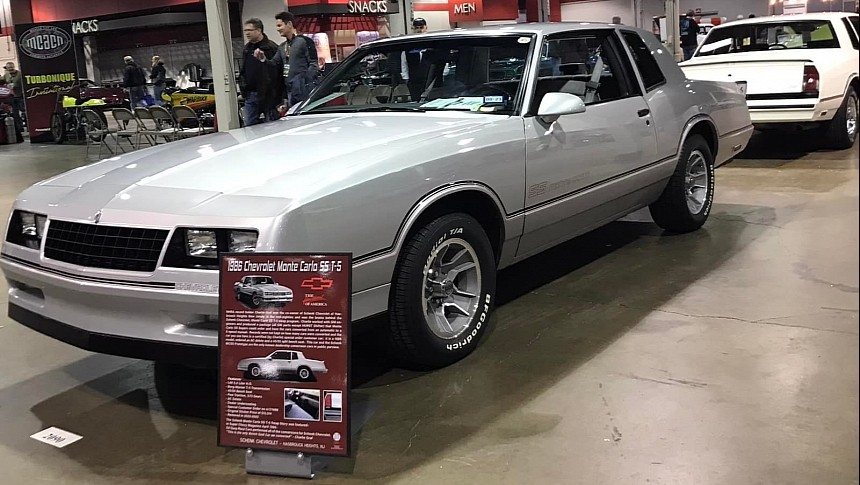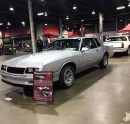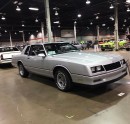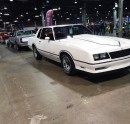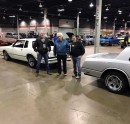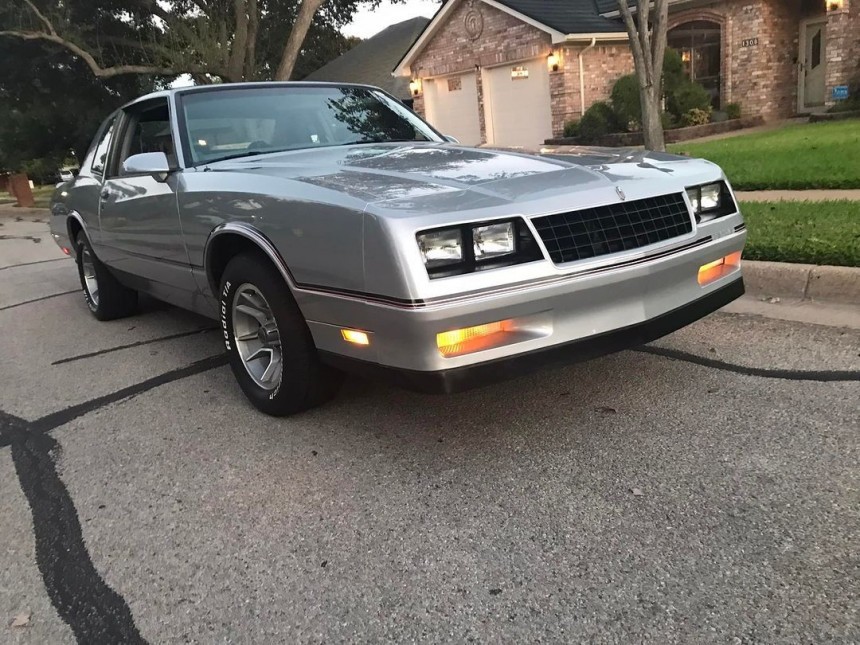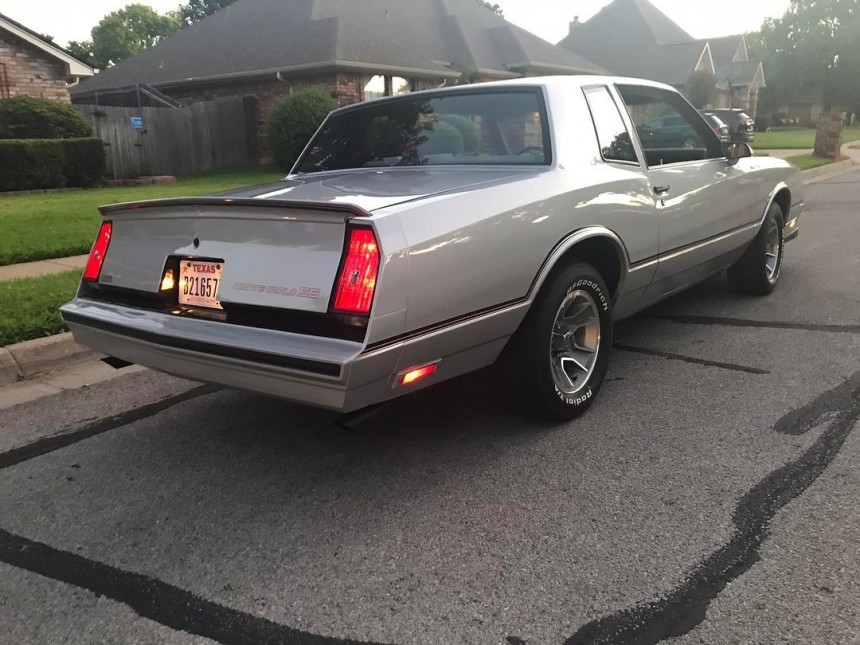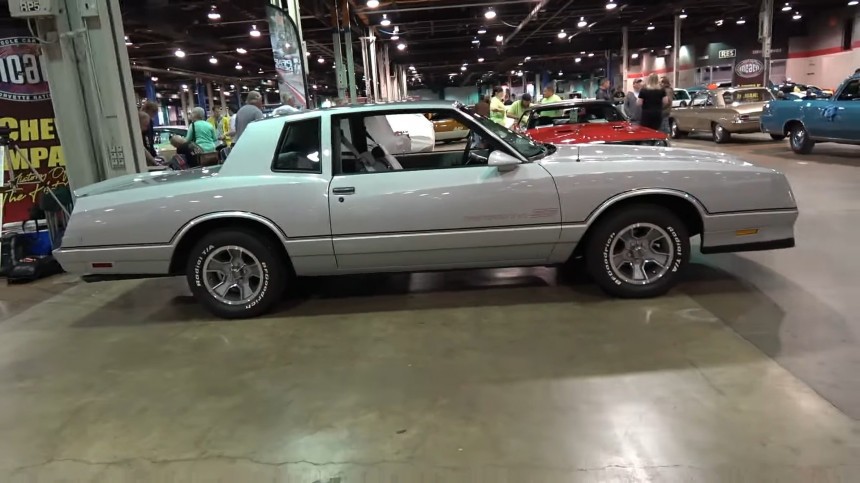Introduced in 1970, the SS variant of the Chevrolet Monte Carlo was axed at the end of 1971, only to be summoned again in 1983. This second coming lasted until the end of 1988 and became the glory days (sales-wise) for the muscular nameplate. But performance was a very different concept in the mid-eighties than what GM had in mind fifteen years prior. The Chevrolet Monte Carlo SS of the mid-eighties wasn’t precisely Super Sporty, as its decals so boisterously claimed. And yet, it spawned one of the most outstanding Monte Carlo variants ever – the five-speed manual SS ‘Schenk.’
The four-speed automatic overdrive gearbox might have been good for cruising. Still, fun-wise, it was as miserable as the depleted 305-cubic-inch (5.0 liters) V8 upfront. Despite the desperation, the SS sales grew each year, from 4,714 units in 1983 to the high water mark of 41,364 in 1986. That year also brought two rarest Chevrolet Monte Carlo Super Sport versions: the Aero Coupe and the dealer-made, GM-backed Schenk T-5.
While the former was built in a limited series of 200 cars, the latter is a mystery with an enticing story. In the eighties, Charlie Graf was one of the two owners of Schenk Chevrolet in New Jersey; he wasn’t particularly fond of the SS and decided to make a good one. (Not better, since he wasn’t thinking that high of the stock automobile). That’s how the elusive five-speed manual Monte Carlo SS of 1986 emerged.
The Schenk Chevrolet Monte Carlo SS used a Borg-Warner T5, had a cowl induction hood, 44 other parts sourced from General Motors, and a floor-mounted Hurst Shifter. The build was easier than expected since the mid-eighties; Monte Carlos utilized the same floor pan as the 1978 model. Incidentally, the older car had a four-speed manual transmission, and the dimples in the transmission tunnel (intended as guides for the stick shifter) made the conversion all the more convenient.
The car was chosen out of coincidence rather than meticulous calculation. Charlie Graf had a trade-in SS with some 1,500 miles on the clock in the showroom (the former owner bought it new, then decided a Corvette was a better option). Since the dealership's mechanical department was too busy to refit the car, the project was outsourced to a speed shop in Pennsylvania.
But before putting out the package for customers, the ugly side of this transmission-swap job emerged: it was too costly for the dealership, so Schenk Chevrolet of New Jersey didn’t build customer cars. Other than the prototype and one other example, seen in the video below at last November's Muscle Car and Corvette Nationals, all the others were built in Pennsylvania.
The current owner, Phillip Madden, bought it in 2021 through the Facebook marketplace, and he was unaware of what the car was at the time. The intention was clear – LS3-swap it and plant a six-speed in it. However, being a discerning gearhead, he ran a background check of the car and found it the only Schenk Monte Carlo SS five-speed with a front bench seat.
Instead of dropping a crate motor and hot-rodding it into oblivion, Phillip restored the car to its present condition. The history of this iconic automobile – almost surely one of the first five-speed conversions ever performed – is unclear. Still, the clock's 60,904 miles (98,000 kilometers) are original (and everything else under the hood).
The engine is the standard 305-cube L69 ‘High Output’ small-block found in Camaro IROCs in the mid-eighties, and the rear is the 3.73 Positive Traction found on any regular 1986 Monte Carlo SS. What this car does not have is an air conditioning system. Since the engine wasn’t a power-puncher, with 180 hp (183 PS) and 240 lb-ft (325 Nm), horsepower-robbing ancillaries could be discarded without remorse.
To convince General Motors to issue a factory warranty on these cars, Charlie Graf, the dealership's co-owner who offered the conversion package, turned his attention south. Across the Rio Negro, to be specific, at the Mexican market, where a four-speed manual Monte Carlo was sold. Since the only significant modification Schenk did was to replace the gearbox, it was easy to get GM to offer a manual alternative for the SS in its homeland.
To get a five-speed SS, the customers would first order a standard Monte Carlo Super Sport and a conversion package, after which the car and the kit were dispatched to Pennsylvania for upgrading. Ed Quay Race Cars was the shop in charge of the swap since they had produced the prototype.
In April 1986, the test mule was showcased in the Super Chevy magazine – read the article in the photo gallery – and that got the excitement going. Coincidence or not, this example featured in the attached video was ordered on April 7, 1986, with a sticker price of $13,314. Surprisingly, the hardest part of the job was sourcing a functional cowl-induction hood that fed 750 CFM (21 cubic meters/min) of fresh air into the Rochester Quadra-Jet four-barrel carburetor.
While the former was built in a limited series of 200 cars, the latter is a mystery with an enticing story. In the eighties, Charlie Graf was one of the two owners of Schenk Chevrolet in New Jersey; he wasn’t particularly fond of the SS and decided to make a good one. (Not better, since he wasn’t thinking that high of the stock automobile). That’s how the elusive five-speed manual Monte Carlo SS of 1986 emerged.
The Schenk Chevrolet Monte Carlo SS used a Borg-Warner T5, had a cowl induction hood, 44 other parts sourced from General Motors, and a floor-mounted Hurst Shifter. The build was easier than expected since the mid-eighties; Monte Carlos utilized the same floor pan as the 1978 model. Incidentally, the older car had a four-speed manual transmission, and the dimples in the transmission tunnel (intended as guides for the stick shifter) made the conversion all the more convenient.
But before putting out the package for customers, the ugly side of this transmission-swap job emerged: it was too costly for the dealership, so Schenk Chevrolet of New Jersey didn’t build customer cars. Other than the prototype and one other example, seen in the video below at last November's Muscle Car and Corvette Nationals, all the others were built in Pennsylvania.
The current owner, Phillip Madden, bought it in 2021 through the Facebook marketplace, and he was unaware of what the car was at the time. The intention was clear – LS3-swap it and plant a six-speed in it. However, being a discerning gearhead, he ran a background check of the car and found it the only Schenk Monte Carlo SS five-speed with a front bench seat.
The engine is the standard 305-cube L69 ‘High Output’ small-block found in Camaro IROCs in the mid-eighties, and the rear is the 3.73 Positive Traction found on any regular 1986 Monte Carlo SS. What this car does not have is an air conditioning system. Since the engine wasn’t a power-puncher, with 180 hp (183 PS) and 240 lb-ft (325 Nm), horsepower-robbing ancillaries could be discarded without remorse.
To convince General Motors to issue a factory warranty on these cars, Charlie Graf, the dealership's co-owner who offered the conversion package, turned his attention south. Across the Rio Negro, to be specific, at the Mexican market, where a four-speed manual Monte Carlo was sold. Since the only significant modification Schenk did was to replace the gearbox, it was easy to get GM to offer a manual alternative for the SS in its homeland.
In April 1986, the test mule was showcased in the Super Chevy magazine – read the article in the photo gallery – and that got the excitement going. Coincidence or not, this example featured in the attached video was ordered on April 7, 1986, with a sticker price of $13,314. Surprisingly, the hardest part of the job was sourcing a functional cowl-induction hood that fed 750 CFM (21 cubic meters/min) of fresh air into the Rochester Quadra-Jet four-barrel carburetor.
